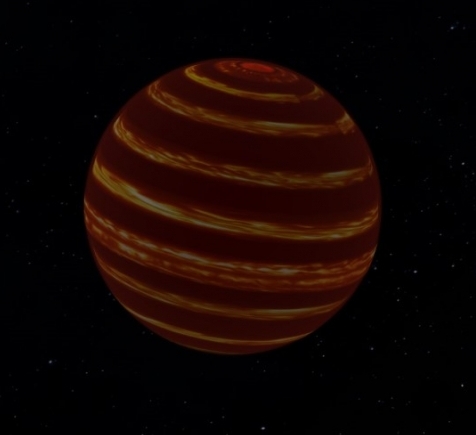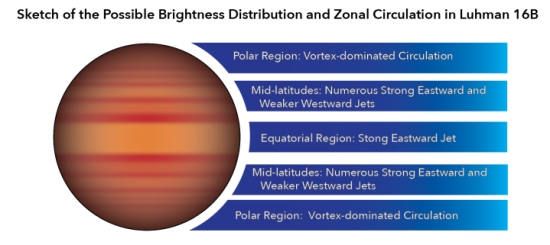I keep hoping we’ll find a brown dwarf closer to us than Alpha Centauri, but none have turned up yet despite the best efforts of missions like WISE (Wide-Field Infrared Survey Explorer). If there’s something out there, it’s dim indeed. Of course, I wouldn’t be surprised at finding rogue planets between us and the nearest stars. Maybe some will be more massive than Jupiter, but evidently not massive enough to throw an infrared signature of the sort that defines a brown dwarf. Just what lies outside our system’s edge always makes for interesting speculation.
The beauty of finding an actual brown dwarf as opposed to a rogue planet is that we might be dealing with a planetary system in miniature, a fine target in our own backyards. Lacking that, the closest brown dwarf we know is the Luhman 16 AB system, a binary in the southern constellation of Vela some 6.5 light years from the Sun (a little further than Barnard’s Star, making this the third closest known system to the Sun). Here we have one dwarf about 34 times Jupiter’s mass (Luhman 16 A), and another, Luhman 16 B, about 28 times more massive than Jupiter, and because both are brown dwarfs, both are hotter than the planet.
Luhman 16 AB is the subject of a new paper from Daniel Apai (University of Arizona / Lunar and Planetary Laboratory). Apai’s team was intent on finding out what brown dwarfs look like, wondering whether they’d be marked by the kind of well-defined banding and belts we see on Jupiter or roiling with storms of the kind we’ve seen (thanks to Juno) on Jupiter’s poles. The method: Using data from TESS (Transiting Exoplanet Survey Satellite), the researchers deployed in-house algorithms to measure brightness changes of the two brown dwarfs as they rotated. Brighter atmospheric features rotate in and out of view.
What emerged was the most detailed look yet at a brown dwarf’s atmospheric circulation, and that led to conclusions about the appearance of these objects. We now know that Jupiter is a good analogy for what we would see if we could look at Luhman 16 AB up close. The work created a model for Luhman 16 B’s atmosphere showing that high-speed winds run parallel to the brown dwarf’s equator. Also like Jupiter are the apparent vortices emerging in the polar regions. Here we need to pause to thank the late Adam Showman, also of the University of Arizona, whose models predicted this pattern.

Image: Using high-precision brightness measurements from NASA’s TESS space telescope, astronomers found that the nearby brown dwarf Luhman 16 B’s atmosphere is dominated by high-speed, global winds akin to Earth’s jet stream system. This global circulation determines how clouds are distributed in the brown dwarf’s atmosphere, giving it a striped appearance. Credit: Daniel Apai.
The lighter zones shown above are thought to be thin cloud decks illuminated by light from the hot interior, while the darker zones are where thicker cloud decks block interior light. The wind speeds are highest at the equator, dropping at the higher latitudes. The global wind pattern is lost at the poles, which are a region of enormous local storms, as on Jupiter. Most of Luhman 16 B, then, is dominated by global wind patterns rather than localized storms.
Something of a surprise to the team (the paper refers to the development as ‘a stunning feature’) is the changeable, non-periodic nature of the Luhman 16 light curve. Here’s how the authors describe this fact:
…we identify four properties that are shared between the visual lightcurve of this object and the infrared lightcurves of other objects: 1) The lightcurves remain variable over long periods (years); 2) The lightcurve shape evolves, yet it displays characteristic period, which is likely the rotational period of the object (as found in Apai et al. 2017); 3) In spite of the rapid evolution of the lightcurve, the amplitudes over rotational time-scales remain similar and characteristic to the object; 4) The lightcurves tend to be symmetric in the sense of similar amount of positive-negative features, in contrast to, for example, a situation in which a single positive feature appears periodically on an otherwise flat lightcurve, which would indicate a single bright spot in the atmosphere.

Image: This is Figure 16 from the paper. Caption: Sketch of the possible appearance of Luhman 16B, based on the emerging evidence. Zonal circulation models and comparison to Jupiter suggests that low-latitude regions are dominated by the fastest jets, and that wind speeds at mid-latitude are significantly lower. Circulation at the polar regions is likely to be vortex- and not jet-dominated. Cloud cover is likely to be correlated with the atmospheric circulation. Credit: Apai et al.
All this is drawn from TESS lightcurves of Luhman 16 AB covering 22 days and 100 rotations of the binary, allowing the researchers to conclude that both the brown dwarfs in this system show zonal circulation and fit the Jupiter model. It seems apparent that brown dwarfs can serve as more massive analogs of giant exoplanets and could thus help us develop techniques of atmospheric analysis that can be deployed even further from the Solar System. Says Apai:
“No telescope is large enough to provide detailed images of planets or brown dwarfs. But by measuring how the brightness of these rotating objects changes over time, it is possible to create crude maps of their atmospheres – a technique that, in the future, could also be used to map Earthlike planets in other solar systems that might otherwise be hard to see… Our study provides a template for future studies of similar objects on how to explore – and even map – the atmospheres of brown dwarfs and giant extrasolar planets without the need for telescopes powerful enough to resolve them visually.”
The paper is Apai et al. “TESS Observations of the Luhman 16 AB Brown Dwarf System: Rotational Periods, Lightcurve Evolution, and Zonal Circulation,” Astrophysical Journal Vol. 906, No. 1 (7 January 2021). Abstract / preprint.



seemed relevant:
https://scienceandtechnology.jpl.nasa.gov/lunar-farside
“This will enable near-continuous monitoring of the nearest stellar systems in the search for the radio signatures of coronal mass ejections and energetic particle events, and will also detect the magnetospheres for the nearest candidate habitable planets. Simultaneously, FARSIDE will be used to characterize similar activity in our own solar system, from the Sun to the outer planets, including the hypothetical Planet Nine.”
Wondering if they could see any large moons/planets orbiting and transiting Luhman 16 AB Brown Dwarf System from the TESS data? They orbit each other in a 27.5 year period separated by 3.56 AU.
AMAZING HUBBLE ASTROVIDEO: TWO BROWN DWARFS DANCE ACROSS THE SKY.
https://www.syfy.com/syfywire/amazing-hubble-astrovideo-two-brown-dwarfs-dance-across-sky
https://fastly.syfy.com/sites/syfy/files/styles/1100xauto/public/wire/legacy/luhman16ab_orbit.jpg
Looks like enough space between the two for even some earth to superearth sized moons.
Hubble Space Telescope astrometry of the closest brown
dwarf binary system. I. Overview and improved orbit?
https://arxiv.org/pdf/1706.00657
Luhman 16.
https://en.wikipedia.org/wiki/Luhman_16
Brown dwarf vs luminous stars.
Is it possible that there is a sharp demarcation between the star types depending on the presence or absence of these banded atmospheric wind patterns indicating whether there is continuous H2 fusion or not? This might be a better feature than surface temperature or mass.
At the transition point, what happens to these bands. Do they start to form is the H2 fusion fails, or do the convection cells start to form if H2 fusion becomes stable?
I was flipping through the paper and I had the exact same thought. At some size we should see a transition between horizontal cell/zone circulation and vertical convection. That is, as the thermal emission increases there will be a point where the heat will disrupt and then eliminate the horizontal flow until, like the sun, there is a single horizontal “zone” that becomes the photosphere.
Is there any evidence of banding on the smallest red dwarfs? To speculate wildly, the flaring activity of red dwarfs may be related to that transition, where the horizontal flow and vertical convection combince to cause chaotic flows with episodic appearance of high velocity eruptions.
Good question. But I’ve never run into anything on banding in the smallest red dwarfs. Worth looking into.
The X-ray flaring is produced by the chaotic magnetic fields arising from a combination of brown dwarfs’ complete convection and rapid rotation.
The magnetic field contortions require (to my understanding) that the conditions on the surface create a plasma: temperature, pressure, gas composition. Do brown dwarfs have that? Red dwarfs do. I am no expert on the stellar and sub-stellar classifications in the transition region and whether plasma formation is the critical factor rather than just internal heat-driven vertical convection cells.
The less massive and cooler a brown dwarf the 1/ more molecular components/cloud types added to its atmosphere – at increasingly low levels ( from TiO and CO for L dwarfs, then iron, methane and water for T dwarfs and finally ammonia ,sulphides et al for Y dwarfs ) and 2/ the less the internal heat of creation to drive winds . So less speed.
The continuous banding seen in L dwarfs is consistent with the brisk 1350 mph winds aligning its one level , high atmosphere TiO/CO clouds.
As different types of clouds are added in at different depths , with different wind speeds, one would expect this to present a patchy appearance as opposed to neatly banded observations in the more massive dwarfs .
I am not clear what you mean by “less speed” here. The gas giants and ice giant planets in our solar system have high sustained wind speeds of hundreds of km/h and more. Uranus’ winds are driven by condensation, rather than internally generated heat. Why should not a similar mechanism apply to cool BDs to maintain wind speeds?
Hi
Next to Red Dwarfs these objects are one of my favorite subjects, Daniel Apai artwork was a very good impression of what these objects look like.
It sure would be amazing to find one closer
Cheers Edwin
Probably the best collection of brown dwarf literature I know of.
http://web.mit.edu/~ajb/www/presentations.html
The gravity focal line of these creatures is surprisingly close, closer than our sun’s FL and the density is hard to imagine, multiples of lead !
If there is a rocky world orbiting one these Dwarfs, I see only one
source of Heat, that would give gradients of energy.
If the 2nd dwarf is close enough, there might be partial mantle
outpouring into upper crust from gravitational interaction, It’s a fine balance though enough energy for underwater thermal vents and abode for life, and enough vulcanism to maintain an atmosphere, and not create one too thick.
It’s the fast rotation and Coriolis force that cause the bands on a gas giant and a brown dwarf. A red dwarf does not have bands because it is a plasma near the surface and there is more convention in a lighter material. There are cloud layers on a brown dwarf.